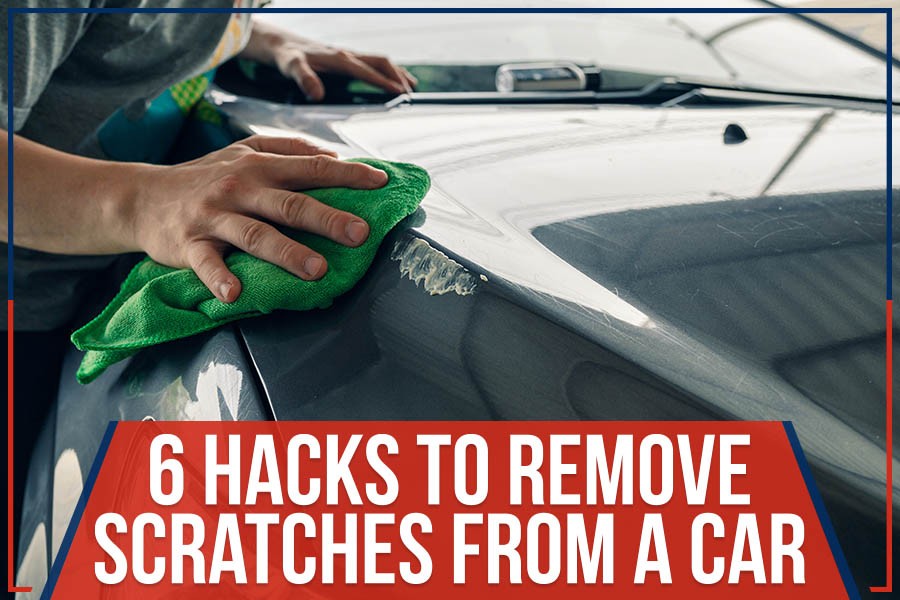Scratches on your car are an unavoidable part of vehicle ownership. Whether it’s a minor scrape from a rogue shopping cart or a more noticeable line from brushing against a bush, these blemishes can detract from your car’s appearance and even its resale value. Learning How To Get A Scratch Out Of My Car is a valuable skill for any car owner. Fortunately, many scratches can be addressed at home without expensive professional repairs. This guide will walk you through various methods, from simple DIY fixes to knowing when it’s time to call in the experts.
 6 Hacks To Remove Scratches From A Car
6 Hacks To Remove Scratches From A Car
Understanding Car Scratches
Before diving into scratch removal, it’s helpful to understand the anatomy of your car’s paint and the different types of scratches. Car paint typically consists of several layers:
- Clear Coat: This is the top, protective layer that provides shine and protects the color coat. Most minor scratches only affect the clear coat.
- Color Coat (Base Coat): This layer provides the actual color of your car. Scratches reaching this layer are more noticeable.
- Primer Coat: This layer helps the color coat adhere to the metal and provides corrosion protection. Scratches that penetrate to the primer require more extensive repair.
- Metal/Body Panel: The actual body of your car. Scratches reaching the metal are the most serious and can lead to rust.
Identifying the depth of the scratch is crucial in determining the best removal method. A simple test is to run your fingernail across the scratch. If your nail doesn’t catch, it’s likely a clear coat scratch and easier to fix. If it catches, the scratch is deeper and may require more aggressive methods or professional intervention.
DIY Methods for Minor Car Scratch Removal
For light scratches that haven’t penetrated beyond the clear coat, you can often achieve satisfactory results using common household items or readily available products. Here are several popular DIY methods for how to get a light scratch out of your car:
1. Toothpaste
Believe it or not, toothpaste can be effective for removing very minor clear coat scratches. The mild abrasives in toothpaste work to gently buff out the scratch, smoothing the edges and making it less visible.
How to use toothpaste for scratch removal:
- Clean the area: Wash and dry the scratched area of your car thoroughly.
- Apply toothpaste: Apply a small amount of non-gel toothpaste (white toothpaste works best) to a clean, soft microfiber cloth.
- Rub gently: Using circular motions, gently rub the toothpaste into the scratch for about 30 seconds to a minute.
- Rinse and dry: Rinse the area with water and dry with a clean microfiber cloth.
- Inspect: Check if the scratch is less visible. Repeat the process if needed.
Toothpaste is best for superficial scratches and may not work on deeper imperfections.
2. Baking Soda Paste
Similar to toothpaste, baking soda has mild abrasive properties that can help buff out minor scratches. Creating a paste with baking soda and water can be another effective DIY solution.
How to use baking soda paste for scratch removal:
- Create a paste: Mix baking soda with water in a small bowl to create a thick paste. A 1:1 ratio is generally effective.
- Apply the paste: Apply the baking soda paste to a clean, damp microfiber cloth.
- Rub gently: Rub the paste onto the scratch using gentle circular motions. Apply light pressure for about 30 seconds to a minute.
- Rinse and dry: Rinse the area thoroughly with water and dry with a clean microfiber cloth.
- Evaluate: Check the scratch. You can repeat the process for better results if the scratch is still visible.
Baking soda is another gentle abrasive, making it suitable for very fine scratches on the clear coat.
3. Vinegar Solution
While not abrasive, a vinegar solution can be helpful for removing very light surface scratches or scuff marks, primarily by cleaning the area and potentially smoothing out minor imperfections in the clear coat.
How to use a vinegar solution for scratch removal:
- Prepare the solution: Mix equal parts white vinegar and water in a spray bottle or bowl.
- Apply the solution: Spray or apply the vinegar solution to a clean microfiber cloth.
- Wipe the scratch: Gently wipe the scratched area with the damp cloth.
- Dry the area: Dry the area with a clean, dry microfiber cloth.
- Assess: Check if the scratch has improved. Vinegar is best for very superficial marks and might not be effective for noticeable scratches.
4. Clear Nail Polish (for Deep Clear Coat Scratches)
For slightly deeper scratches that are still within the clear coat but more pronounced, clear nail polish can act as a temporary sealant and make the scratch less visible. This method is more about concealing the scratch than removing it, and it’s crucial to use clear nail polish only.
How to use clear nail polish for scratch concealment:
- Clean the scratch: Thoroughly clean and dry the scratched area.
- Apply thin layers: Apply very thin, even layers of clear nail polish directly into the scratch using the brush applicator. Let each layer dry completely before applying the next. Multiple thin coats are better than one thick coat to prevent drips and ensure even filling.
- Allow to dry completely: Let the final coat of nail polish dry completely, ideally for several hours.
- Buff excess (optional): If there’s any excess nail polish around the scratch after drying, you can very gently buff it with a polishing compound and a soft cloth to level it with the surrounding paint. However, be extremely careful not to scratch the surrounding paint further.
Important Note: This method is primarily for concealing clear coat scratches and preventing further damage by sealing the scratch. It’s not a permanent fix and may not be suitable for scratches that reach the color coat or primer. Using colored nail polish is generally not recommended as color matching is extremely difficult and can make the problem worse.
5. Commercial Scratch Removal Products
For more effective DIY scratch removal, especially for scratches that are beyond very minor surface level, commercial car scratch removal products are readily available at auto parts stores. These products are specifically formulated to remove car scratches and come in varying strengths for different scratch depths.
How to use commercial scratch removers:
- Choose the right product: Select a scratch remover appropriate for the type and depth of scratch you’re dealing with. Read product descriptions carefully. For minor scratches, a “scratch and swirl remover” may suffice. For slightly deeper scratches, a more abrasive “scratch repair compound” might be necessary.
- Clean the area: Thoroughly wash and dry the area around the scratch.
- Apply product: Apply a small amount of scratch remover to a clean applicator pad or microfiber cloth (as directed by the product instructions).
- Rub and buff: Rub the product into the scratch using firm, even, circular or back-and-forth motions as instructed by the product. Some products require hand application, while others can be used with a machine polisher for more effective results.
- Wipe off residue: Wipe off any excess product with a clean microfiber cloth.
- Inspect: Check the scratch. You may need to repeat the process or apply a car wax or sealant to protect the repaired area and enhance shine.
Commercial scratch removal kits often come with multiple compounds and applicators. Always follow the manufacturer’s instructions carefully for best results and to avoid damaging your car’s paint. Avoid extremely cheap, budget kits as they may contain harsh abrasives that can do more harm than good.
When to Contact a Professional for Car Scratch Repair
While DIY methods can be effective for minor scratches, deeper or more extensive damage requires professional attention. It’s time to consult a professional for car scratch repair in the following situations:
- Deep scratches reaching primer or metal: If the scratch is deep enough that you can see the white or gray primer layer or bare metal, DIY methods are unlikely to provide a satisfactory or lasting repair. Professional repair is necessary to prevent rust and properly restore the paint layers.
- Large or complex scratches: Extensive scratches, scratches across multiple panels, or scratches in intricate areas are best handled by professionals who have the tools and expertise for seamless repairs.
- You want a guaranteed, flawless finish: Even with the best DIY efforts, achieving a truly flawless, undetectable repair can be challenging. Professional paint shops have color-matching technology and specialized equipment to ensure a perfect match and finish.
- You’re concerned about damaging your car’s paint: If you’re unsure about using DIY methods or worried about potentially making the scratch worse, it’s always safer to consult a professional.
Professional scratch repair services offer several advantages:
- Expert color matching: Professionals can precisely match your car’s paint color for seamless repairs.
- Proper tools and techniques: They use specialized tools and techniques like sanding, filling, priming, and professional-grade paints and clear coats for durable and high-quality repairs.
- Warranty: Professional repairs often come with a warranty, providing peace of mind and protection against future issues.
- Expert advice: Professionals can provide advice on maintaining your car’s paint and preventing future scratches.
A professional technician expertly repairs a deep car scratch, ensuring a seamless color match and finish.
Conclusion
Knowing how to get a scratch out of your car empowers you to maintain your vehicle’s appearance and potentially save money on minor repairs. From using household items like toothpaste and baking soda for superficial scratches to employing commercial scratch removers for slightly deeper imperfections, DIY methods offer viable solutions for many common car blemishes. However, for deep scratches that penetrate beyond the clear coat, or for extensive damage, professional repair is the best course of action to ensure a high-quality, lasting result and protect your car’s value. Regularly addressing scratches, whether through DIY or professional services, is a key aspect of responsible car ownership and helps keep your vehicle looking its best for years to come.
